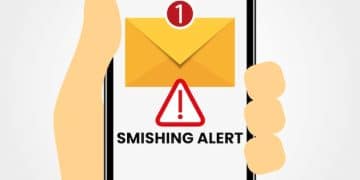Phishing Email Alert: Protect US Consumers from 2025 Scams

Phishing email alerts are crucial for protecting US consumers in 2025; this article outlines the latest scams, how to spot them, and effective prevention strategies to safeguard your personal and financial information from malicious actors.
The digital landscape is constantly evolving, and so are the tactics of cybercriminals. In 2025, phishing email alerts: spot the latest scams targeting US consumers, remaining a persistent threat, adapting to new technologies and preying on unsuspecting individuals. This article will explore the latest phishing scams targeting US consumers, providing insights on how to identify and avoid them, ensuring your online safety.
Understanding the Evolving Threat of Phishing Emails
Phishing emails remain a significant cybersecurity threat, constantly evolving to bypass security measures and deceive users. Understanding these evolving tactics is crucial for protecting yourself and your personal information. Scammers continuously refine their methods, making it increasingly difficult to distinguish legitimate emails from malicious ones.
Common Phishing Techniques in 2025
Phishers use various techniques to trick users into revealing sensitive information. Here are some common methods:
- Spear Phishing: Targeted attacks that focus on specific individuals or organizations, using personalized information to increase credibility.
- Whaling: Phishing attacks aimed at high-profile targets such as executives or celebrities, seeking to steal valuable data.
- Smishing: Phishing attempts conducted via SMS (text messages), often involving fraudulent links or requests for information.
- Vishing: Phishing attacks carried out through phone calls, where scammers impersonate legitimate organizations to extract information.
Staying informed about these techniques can significantly reduce your risk of falling victim to phishing scams.

How Phishing Emails Bypass Security Measures
Phishers employ sophisticated techniques to circumvent security measures, including:
- Spoofing: Masking the sender’s email address to appear as a legitimate source, such as a bank or government agency.
- Using URL Shorteners: Hiding malicious links behind shortened URLs to prevent users from recognizing suspicious destinations.
- Employing Social Engineering: Crafting emails that exploit human psychology, such as creating a sense of urgency or fear to prompt immediate action.
- Exploiting Zero-Day Vulnerabilities: Taking advantage of newly discovered software vulnerabilities before patches are available, allowing them to install malware or steal data.
By understanding these methods, you can better identify and avoid phishing attempts.
In conclusion, the evolving threat of phishing emails requires constant vigilance and education. Staying informed about the latest techniques and security measures can significantly reduce your risk.
Identifying Red Flags: Key Indicators of Phishing Emails
Being able to identify the red flags in phishing emails is crucial for protecting yourself from scams. These indicators, while sometimes subtle, can help you distinguish legitimate emails from malicious ones.
Generic Greetings and Typos
One of the most common red flags is a generic greeting, such as “Dear Customer” or “To Whom It May Concern.” Legitimate organizations typically address you by name. Additionally, phishing emails often contain typos, grammatical errors, and awkward phrasing.
Urgent or Threatening Language
Phishing emails frequently use urgent or threatening language to pressure you into taking immediate action. They may claim that your account will be suspended, or that you need to update your information immediately to avoid consequences. This is a classic tactic to create panic and bypass rational decision-making.
Suspicious Links and Attachments
Always be wary of links and attachments in unsolicited emails. Hover over links to see the actual URL before clicking, and avoid opening attachments from unknown senders. Malicious links can redirect you to fake websites designed to steal your information, while attachments may contain malware.

Here are some key things to check when evaluating links and attachments:
- URL Mismatches: Ensure the URL matches the legitimate website address of the organization.
- File Extensions: Be cautious of unusual file extensions, such as .exe or .zip, as they can contain malware.
- HTTPS Protocol: Check if the website uses HTTPS, indicating a secure connection.
Inconsistencies in Sender Information
Pay close attention to the sender’s email address and domain name. Phishing emails often use slight variations of legitimate addresses to trick you. For example, instead of @bankofamerica.com, they might use @bankofarnerica.com. Always double-check the sender’s information to ensure it matches the legitimate organization’s contact details.
By recognizing these red flags, you can significantly reduce your risk of falling victim to phishing scams. Vigilance and a healthy dose of skepticism are your best defenses in the digital age.
Real-World Examples: 2025 Phishing Scenarios
Understanding real-world phishing scenarios can provide valuable insights into how these scams operate and what to watch out for. By examining specific examples, you can better prepare yourself to recognize and avoid phishing attempts.
The Fake Invoice Scam
In this scenario, you receive an email with an attached invoice for a product or service you didn’t order. The email urges you to review the invoice and make a payment. The attachment may contain malware, or the email may include a link to a fake website where you are prompted to enter your credit card information.
The Account Suspension Threat
This scam involves an email claiming that your account with a popular online service (e.g., social media, email, or streaming platform) has been suspended due to suspicious activity. The email instructs you to click a link and verify your account details. The link leads to a phishing site that steals your username and password.
The Fake Job Offer
In this scenario, you receive an unsolicited job offer via email. The email may seem legitimate, with a professional tone and company logo. However, the job offer is fake, and the scammers are trying to collect your personal information, such as your social security number and bank account details, under the guise of processing your application.
To better protect yourself against scenarios like these, remember the following:
- Always Verify: Whether it’s a bill, some problem with an account, or an opportunity, always check with the company using contact information from their official website before moving forward
- Trust your gut: Scams are designed to feel off, if anything feels off, don’t move forward
- Don’t share private information: Never share credit cards or personal details with an email provider
The Charity Scam
This scam exploits people’s generosity by sending emails soliciting donations for a fake charity. The email may use emotionally charged language and images to tug at your heartstrings. The scammers pocket the money instead of providing aid to those in need.
Learning about these real-world examples can help you recognize and avoid similar scams. Always be cautious and verify the legitimacy of any email before taking action.
Protecting Yourself: Practical Tips and Strategies
Protecting yourself from phishing emails requires a combination of awareness, caution, and proactive measures. By following these practical tips and strategies, you can significantly reduce your risk of falling victim to phishing scams.
Enable Multi-Factor Authentication (MFA)
Multi-factor authentication adds an extra layer of security to your online accounts. Even if a phisher steals your password, they will still need a second factor, such as a code sent to your phone or a biometric scan, to access your account. Enable MFA on all your important accounts, including email, social media, and banking.
Keep Your Software Updated
Regularly update your operating system, web browser, and security software. Software updates often include security patches that fix vulnerabilities that phishers can exploit. Enable automatic updates to ensure you always have the latest protection.
Use a Reputable Antivirus Program
Install a reputable antivirus program and keep it up to date. Antivirus software can detect and block phishing emails, malicious websites, and malware. Choose a program with real-time scanning and phishing protection features.
Here are a few more things to keep in mind:
- Check Sender: Verify the sender of the email before opening
- Check Links: Before clicking on links make sure they are going to the write place
- Take your Time: Scammers are often trying to get to to rush, so don’t rush and take your time
Educate Yourself and Others
Stay informed about the latest phishing scams and techniques. Share your knowledge with friends and family to help them stay safe online. By educating yourself and others, you can create a more secure online environment for everyone.
Implementing these practical tips and strategies can significantly enhance your protection against phishing emails and other online threats. Vigilance and a proactive approach are essential for safeguarding your personal and financial information.
Leveraging Technology: Tools and Resources for Phishing Protection
In addition to practicing safe online habits, leveraging technology can provide an extra layer of protection against phishing emails. Several tools and resources are available to help you identify and block phishing attempts.
Email Filtering and Spam Detection
Most email providers offer built-in filtering and spam detection features. These features automatically identify and filter out suspicious emails, reducing the risk of phishing attacks. Configure your email settings to maximize spam filtering effectiveness.
Browser Extensions for Phishing Detection
Several browser extensions are designed to detect and block phishing websites. These extensions analyze websites in real-time and alert you if they are suspicious or known phishing sites. Install a reputable phishing detection extension for your web browser.
Password Managers
Password managers not only help you create and store strong, unique passwords but also protect you from phishing attacks. When you visit a website, the password manager automatically fills in your login credentials. If you are on a fake website, the password manager will not recognize it and will not fill in your credentials, alerting you to the potential phishing attempt.
Here are some of the most popular options when it comes to password managers:
- 1Password
- LastPass
- Bitwarden
Website Reputation Checkers
Website reputation checkers allow you to quickly assess the trustworthiness of a website. These tools analyze various factors, such as the website’s age, security certificates, and user reviews, to provide a reputation score. Use a website reputation checker before entering sensitive information on a website.
By leveraging these technological tools and resources, you can enhance your protection against phishing emails and other online threats. Staying informed about the latest technology and using it effectively can make a significant difference in your online safety.
The Future of Phishing: Emerging Trends and Technologies
As technology continues to advance, so do the tactics of phishers. Understanding emerging trends and technologies in the world of phishing is crucial for staying ahead of the curve and protecting yourself against future threats.
AI-Powered Phishing Attacks
Artificial intelligence (AI) is being used to create more sophisticated and convincing phishing emails. AI can generate personalized messages, mimic writing styles, and even create deepfake videos to deceive users. Be wary of emails that seem too good to be true or that contain unexpected requests.
QR Code Phishing (Qishing)
QR codes are increasingly being used in phishing attacks. Scammers create fake QR codes that, when scanned, redirect users to malicious websites or download malware. Always be cautious when scanning QR codes, especially from unknown sources.
Cryptocurrency Scams
With the growing popularity of cryptocurrencies, phishing scams targeting cryptocurrency wallets and exchanges are becoming more common. These scams often involve fake emails or websites that trick users into revealing their private keys or login credentials.
Below are several scams to be on the lookout for
- Fake Exchanges: Scammers will promote fake exchanges, once you put cryptocurrency in there, it is gone
- Ponzi Schemes: These scams are built to look like legitimate investment strategies but are actually designed to take your investment
- Pump and Dumps: Scammers convince small investors to buy a token to artificially inflate the price, they they sell that investment for a profit while everyone else is left with worthless assets
Deepfake Phishing
Deepfake technology is being used to create realistic but fake videos and audio recordings of individuals. Scammers can use deepfakes to impersonate executives or other high-profile individuals and trick employees into transferring funds or revealing sensitive information.
Staying informed about these emerging trends and technologies can help you prepare for the future of phishing and protect yourself against increasingly sophisticated attacks.
| Key Element | Brief Description |
|---|---|
| 🚩 Red Flags | Watch for generic greetings, typos, urgent language, and suspicious links. |
| 🛡️ Protection | Enable MFA, update software, use antivirus, and stay informed. |
| 🤖 Emerging Threats | AI-powered phishing, QR code scams, and cryptocurrency attacks are on the rise. |
| 🔑 Password Management | Use a password manager to create and store strong, unique passwords. |
FAQ
▼
A phishing email is a deceptive message designed to trick you into revealing sensitive information, such as passwords, credit card numbers, or personal details. It often masquerades as a legitimate communication from a trusted source.
▼
Look for red flags like generic greetings, typos, urgent requests, suspicious links, and inconsistencies in the sender’s email address. These are common indicators that an email may be a phishing attempt.
▼
Do not click on any links or open any attachments. Mark the email as spam or junk, and delete it immediately. If you have already clicked on a link or provided information, change your passwords and contact the relevant authorities.
▼
Yes, multi-factor authentication (MFA) adds an extra layer of security to your accounts. Even if a phisher steals your password, they will need a second factor to access your account, significantly reducing the risk of unauthorized access.
▼
Follow cybersecurity news and blogs, subscribe to email alerts from reputable security organizations, and regularly review the latest phishing scam reports. Staying informed is key to protecting yourself from emerging threats.
Conclusion
As we navigate the increasingly complex digital world of 2025, awareness and proactive measures are our strongest defenses against phishing email alerts: spot the latest scams targeting US consumers. By staying informed, leveraging technology, and adopting safe online habits, we can collectively protect ourselves and our communities from the ever-evolving threat of phishing scams.





